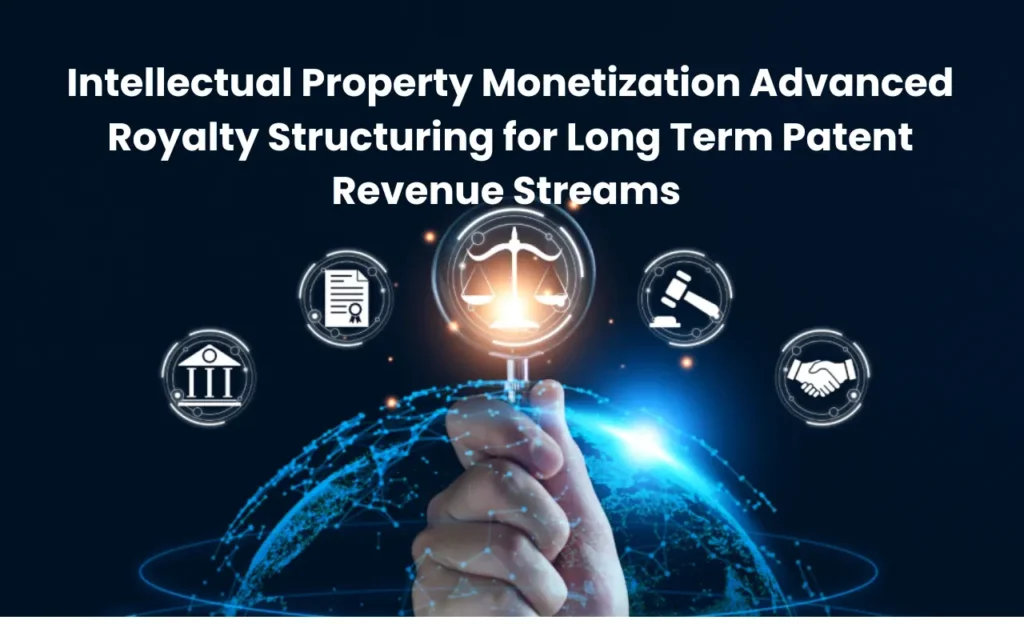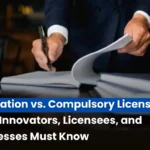
With the knowledge economy now, patents have evolved to become business assets not only guarding intellectual property monetization but also creating long-term sources of income. The optimal use of patents to produce a steady source of income would perhaps be by means of royalty agreements. But royalties are not maximally exploited because there is no systematic and strategic planning. Sophisticated royalty structuring offers patent owners the ability to optimize long-term cash flows from their intellectual property at reduced risk with more cash. This article discusses the different factors, strategies, and techniques of sophisticated royalty structuring in long-term patent revenue streams.
Understanding Patent Royalties
Royalties are payments made to a patentee by a licensee in consideration for using, manufacturing, or selling a patented invention. Royalties may be in the form of one or a series of forms, depending on the agreement of the parties. Royalties are usually a percentage of revenue obtained on the patented item, or otherwise a sequence of periodic fixed instalments.
Importance of Royalty Structuring
Structuring of royalty must be done to ensure stable returns over patents in the long run. Structuring of a royalty deal in the right form not only leads to assured cash flows but also ensures the alignment of the licensor and licensee’s interests. Proper structuring can minimize disputes, provide scope for movement in the marketplace, and drive innovation.
Key Components of Royalty Structuring
Royalty Rate Determination
- Fixed Royalty Rate: Fixed rate of sales revenue.
- Tiered Royalty Rate: Multi-levelled rates based on sales level, product milestones, or time periods.
- Hybrid Royalty Rate: Mix of fixed and tiered with simplicity.
Payment Frequency
- Regular payments are made monthly, quarterly, or annually.
- Production or sales milestones payment, in terms.
Upfront Payments and Minimum Guarantees
- Upfront Fees: Single payment prior to commercialization.
- Minimum Royalty Guarantees: Minimums paid regardless of sales performance.
Royalty Escalators
- Increasing rates of royalty when achieving specific levels of hardware sales or length of license periods.
Territorial Scope
- Restrictions on areas where the patent may be enforced.
Product-Specific Royalties
- Different rates for different products that are manufactured out of the patented technology.
Audit Rights
- Provisions in contracts granting rights to patent owners to audit books of licensees, in the direction of correct patent royalty calculation.
Advanced Royalty Structuring Strategies
Hybrid Royalty Models
Hybridized fixed and variable royalties can potentially produce a best-balanced solution to satisfy both the needs of the licensor and that of the patentee. It will tend to produce a low rate of fixed percentage in revealing a product for the first time into a new market where market uncertainty is the situation, and sales volume is moderate. After the product takes off in the market and sales start stabilizing, the royalty rate can be increased to battle rising value and demand for the patented technology.
Advantages:
- Saves the licensee’s money at market entry.
- Takes the battle for acceptance of the product tough to the licensees.
- Sacs the patent owner financially as revenues rise as sales gain.
Revenue Sharing Partnerships
As opposed to standard fixed royalty terms, revenue-sharing arrangements involve the division of a percentage of the gross revenue of the patented product. In this arrangement, licensee and patentee financial interests are combined in collaborative efforts towards optimum product outcomes.
Key Features:
- Negotiation of percentage share of revenue on the basis of market potential.
- Revenue rules of computation and reporting with specificity.
- Arrangements for adjustment to revenue shares by reason of changes in market conditions.
Benefits:
- Incentivizes the licensees to invest additional money in marketing and selling the products.
- Provides the patent holders with a superior reward in the event that the product is successful.
- Incentivizes stable long-term arrangements between the patent holders and the licensees.
Performance-Based Royalties
This model links royalty payments to measurable performance targets like sales volumes, market share, or product quality goals. Performance royalties will encourage licensees to drive sales volumes higher, thus conferring benefits to the patent owner as well if the product performs well.
Examples of Performance Metrics:
- Sell a specified number of units.
- Achieve a target share of market.
- Receive good product quality ratings or certifications.
Benefits:
- Adjusts royalties based on performance of the market.
- Limits risk to owner of patent by paying proportionately to product success.
- Motivates licensees to aim at market penetration and quality.
Royalty Prepayment Discounts
Licensees can be provided by patent owners with a prepayment discount for the royalty rate. It can be very favourable to patent owners who need earlier cash flow, whereas cost savings can be highly appreciated by licensees later on.
Structure:
- Accelerate lump sum prepayment of future royalty obligations.
- Discounted prepayment for prepayment of royalty payments on licensing.
- Flexible as part prepayment and subsequent adjustment.
Benefits:
- Provides patent owners early liquidity to invest in R&D or other business ventures.
- Sacrifices administrative cost savings on periodic royalty collection.
- Incentivizes financially sound licensees who are willing to purchase discounted rates.
Equity-Based Royalty Agreements
Where the licensees are emerging or growing enterprises with limited cash flows, patent owners may accept business equity as a substitute for royalty payments in the royalty contract. The equity-for-royalty arrangement aligns the patent owner’s interests to be aligned with the long-term prosperity and success of the licensee.
Key Considerations:
- Valuation to establish fair value.
- interests in ownership and vesting schedules.
- value realization exit opportunities for equity.
Advantages:
- Opens doors to enormous returns to the owners of patents in the event that the licensee expands.
- Reduces pressure on start-ups when they begin to expand.
- Simple construction and long-term partnership.
Licensing Pools
Licensing pools are where different owners of patents pool their patents and license them as a package. The model works best with complementary patent access technologies such as telecommunications, manufacturing, and computer software.
How It Works:
- Owners of patents pay their patents into a pool owned by a licensing agency.
- Licensees get rights over the whole pool under terms standardized.
- Royalties are divided between patent owners according to agreed terms.
Benefits:
- Simplifies product licensing through several patents.
- Maximizes market coverage and utilization of technology.
- Provides equal royalty income to every pool member.
Cross-Licensing Agreements
Cross-licensing is a situation in which two or more patent owners license each other to use their own patents. The technique is the preference of technology firms to stop litigation and enable mutual advantages of innovation.
Key Aspects:
- Reciprocally agreed licensing terms to achieve equal gain.
- Compensation terms to adjust based on relative worth of cross-licensed patents.
- Restraints to avoid aggressive use of patented technology.
Advantages:
- Saves payment of royalties and licensing fees in certain situations.
- Enhances business relationships and facilitates collaborative R&D.
- Lowers risk of litigation and provides freedom to operate.
Read Also: Apple Patent Monetization Case Study: How IP Increases Market Dominance
Risk Mitigation in Royalty Structuring
- Royalty Floor Clauses: Provide for guaranteed minimum payments despite sales performance.
- Termination Rights: Specify conditions under which the license agreement can be terminated.
- Legal Recourse: Define process of resolving disputes, e.g., arbitration or litigation processes.
- Territorial Safeguards: Permit royalties to be sufficiently well-crafted for global markets, taking regional rules and taxes into account.
Valuation of Long-Term Royalty Streams
Patent valuation professionals use approaches such as Discounted Cash Flow (DCF), Market Comparable, and Royalty Relief methodologies to calculate the current value of future royalty streams. Proper valuation enables patent holders to secure excellent deals and interest prospective investors.
Case Studies
- Pharmaceutical Industry: Drug patents usually have stepped royalties with escalators keyed to approval milestones or volume sales.
- Technology Sector: Software patents usually have hybrid royalties, i.e., a combination of upfront payments and continuous royalty payments on license users.
- Consumer Electronics: Cross-licensing deals among technology leaders minimize litigation exposures and create settled revenue-sharing agreements.
Future Trends in Royalty Structuring
- Data-Driven Royalty Models: Usage of data analytics for the prediction of. Sales performance and dynamic royalty rates.
- Blockchain for Royalty Tracking: Use block chain technology to make royalty tracking transparent and autonomous.
- Royalty Tokenization: Tokenize future royalties into investment and liquidity potential with tradable digital tokens.
Conclusion
Sophisticated royalty structuring is a potent tool for patent owners who are working to maximize long-term profitability. Carefully structuring royalty transactions with flexible pricing, incentive pay tied to performance, and risk management allows patent owners to capture stable profits while forming successful alliances. Through constant evolution of the patent space, innovative royalty structures will continue to fuel long-term sustainable patent monetization and facilitate innovation globally.
Read More: Huawei Earns Over $600 Million From Patent Licensing in 2024
-
Pingback: Developing a Patent Exit Strategy - Patent Monetize
-
Pingback: Unlocking Patent Value in Autonomous- Patent Monetize




